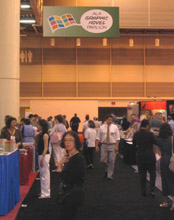
A lot more graphic novel product for kids and teens is in the pipeline, based on our observations at the American Library Association Annual Conference that wrapped in
The increasing penetration of graphic novel material into school and public libraries continues across all categories, with the broad range of graphic novel material and how to categorize it and provide it for age-appropriate users the biggest problems faced by librarians.
Two panels offered help in the area. 'Graphic Novels for Children? The Wave of the Future' specifically looked at graphic novels for elementary school-age children; and 'Graphic Novels, Manga, and Anime: What's New and Cool for Your Library,' sponsored by YALSA, looked at offerings for older readers as well. We counted around 170 people in the YALSA panel, and churn over the 90-minute span probably meant that 200 people took in all or part of the panel.
With this kind of continued interest from the librarians and educators that are teaching kids to read, a new generation of children is being taught the lexicon of comics, and to appreciate the form. Although the phenomenon is new, it has the potential to further expand the growing audience for the comic art form.
Many of the graphic novel exhibitors were concentrated in the Graphic Novel Pavilion, which the Exhibit Guide described as 'the largest- and fastest-growing' of the pavilions. But as was the case at the BEA (see 'BEA 2006 -- Graphic Novels Come of Age'), there were also graphic novels throughout the floor, at the booths of the publishers from other categories that have entered the business.
Publishers exhibiting new library/educational-oriented graphic novel lines included Osprey (see 'Osprey Plans Graphic History Line'), which had advance copies of its Hell Broke Loose graphic novel of the Battle of Gettysburg (since retitled to Gamble for Victory over concerns over the title); and Lerner (see 'Graphic Universe to Publish Mythology Titles'), which had a 16-page sampler for its Hercules book.
Scholastic was distributing copies of its excellent Using Graphic Novels in the Classroom, a 16-page booklet that uses Bone to explain the value and uses of graphic novels in the classroom.
And back in the graphic novel pavilion, the circle was completed as publishers like Tokyopop, Viz, and Dark Horse displayed their prose fiction lines.
Attendance was down from recent years, primarily because of the location. One exhibitor told us that he was seeing more high school librarians this year, following up the growth at the middle school level last year.








